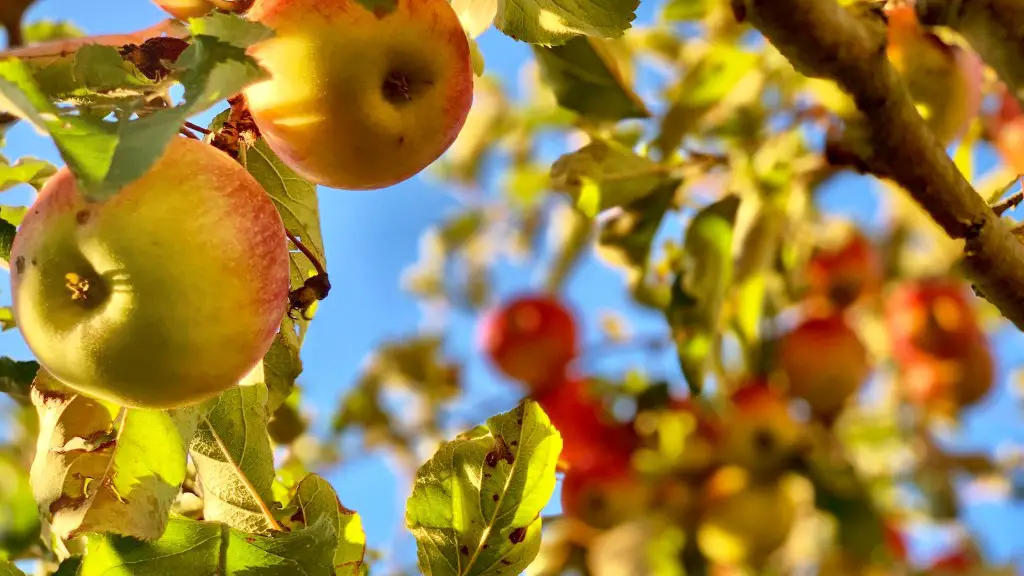Dwarf apple trees are small-sized trees that are becoming increasingly popular. In comparison to other apple tree varieties, they are usually more manageable and easier to maintain, making them an easy-to-grow choice for both commercial and residential growers alike. But how fast and how big do these trees get? Let’s take a closer look.
Dwarf apple trees can reach an average height of 6-8 feet, although some may grow up to 12 feet. Depending on the variety, these smaller trees can produce more fruit within a shorter period of time. Their shorter size makes them superb for small garden spaces and areas of limited height, making them well-suited for patios, deck areas, and other garden nooks and crannies.
These trees are also pruned to keep them controlled in size and shape. This helps to induce heavy flowering and fruiting for a larger harvest, as well as reducing their overall size. Dwarf apple trees need to be pruned in late winter, early spring, and then before the end of summer. This will help to keep the tree compact, while also allowing light and air to reach the inside of the canopy, allowing the fruits to ripen instead of becoming diseased.
Fertilizer application is also essential for Dwarf apple trees in order for them to reach their peak production levels. A good general fertilizer should be used and applied every third week during the growing season, followed by twice a year in the late winter and early spring months. This will help to ensure the tree has all the essential nutrients to promote healthy growth, flowering, and fruiting.
To ensure fruit production, it’s important to pollinate Dwarf apple trees with a compatible pollinizer. Luckily, these trees don’t require a lot of space, so even a small sized garden can support one pollinizer tree. Planting compatible pollinizers near them will help with fertilization, thus boosting the production and size of the fruit.
Pruning Technique
The technique used to prune a dwarf apple tree is similar to that used for larger trees. To maintain size, only maintaining branches are left unpruned, and those that are pruned back should be done so to 1/3 of their length. This promotes new growth, while also allowing enough leaves to remain so that the tree receives the necessary levels of sunlight and air flow. Care should be taken to look out for any deadwood and disease, as it can have a lasting impression on the trees’ health.
Watering
Watering is also important for a dwarf apple tree. Depending on the soil type, and climate, a tree should be watered a minimum of twice a week for best results. This should only apply during the growing season, with some additional water likely needed in hotter periods during the summer months. This will ensure that the apple tree receives all the necessary moisture it needs to produce healthy fruits.
Growth and Maturation
Dwarf apple trees usually take 2-3 years before they reach maturity and begin to produce full-size fruit. In rare cases, it could be longer, depending on the care given. During this time, there may be some light flowering, which should be monitored for signs of unhealthy growth so that any problems can be addressed early.
Disease Prevention and Control
To prevent disease and ensure that the tree continues to yield healthy fruit, some regular maintenance is needed. Taking the time to prune away any deadwood and keeping an eye out for signs of disease will help you to stay on top of it before it gets out of control. Regular spraying with an insect and disease prevention agent will also help, especially during bloom and fruiting season.
Harvest and Storage
Knowing when to harvest an apple is important. Some apple varieties will require more ripening time before they should be harvested, so it’s best to consult with an expert or research the variety you are growing to determine the best time. Once harvested, they should be stored in a cool and dry location placed away from direct sunlight. Doing so will ensure that your apples remain fresh and tasty for weeks after harvesting.
Fertilizing and Nutrient Management
It is important to provide the vitamin and mineral needs of a dwarf apple tree to ensure a healthy growth and good productivity. The most important times to fertilize a dwarf apple tree is in the spring and early summer when the tree is actively growing. An organic fertilizer that contains nitrogen, phosphorus, and potassium is recommended for optimum tree health. Also, further nutrients like calcium, magnesium and iron can be added to the tree with a soil fertilizer.
Pest and Weed Control
Taking steps to control harmful pests and weeds is essential for the health of a dwarf apple tree. Common pests such as aphids and codling moths can be treated with natural insecticides like neem oil. Weeds can be removed by hand or by using an herbicide. Keeping the area around the tree well maintained can also help to prevent pests and weeds from taking over.


